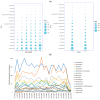Prescription Pattern of Antidepressants and the Potential for Personalized Medicine in the Qatari Population
- PMID: 34068080
- PMCID: PMC8152751
- DOI: 10.3390/jpm11050406
Prescription Pattern of Antidepressants and the Potential for Personalized Medicine in the Qatari Population
Abstract
Studying the prescription pattern of medications will help in understanding potential unnecessary prescriptions, due to the trial-and-error method of prescribing, and the need for personalized medicine in a population. Therefore, in this study, our aim was to explore the prescribing pattern and off-label use of antidepressants in the Qatari population. We conducted a retrospective study of Qatari patients who received prescriptions for antidepressants from the major healthcare providers in Qatar, for a period of 24 months between June 2018 and May 2020. The number of patients, prescriptions, and diagnostic indications were analyzed. The chi-square test was used for identifying statistically significant association of the number of individuals prescribed with age category or gender. Of the 14,601 Qatari patients who were prescribed antidepressants, the majority were female (61%, p < 2.2 × 10-16), and were at or above 60 years of age (27%, p < 2.2 × 10-16). More numbers of selective serotonin reuptake inhibitors (SSRIs) (22,085 out of 48,031; 46%), were dispensed than other classes of antidepressants, with escitalopram (26%) at the top of the list. Preponderance of prescription of antidepressants for non-mental health diseases was observed. Population-level prescription trends, as we reported here, when combined with patient genetic variability and outcome data, will have the power to predict the potential for treatment failures and adverse effects of these medications in the population. We also recommend educating non-mental health prescribers about the adherence to evidence and guidelines to ensure patient safety while prescribing antidepressants.
Keywords: Middle East; antidepressants; prescription pattern.
Conflict of interest statement
The authors declare no conflict of interest.
Figures





Similar articles
-
Prescription Pattern and Off-Label Use of Antipsychotics in a Middle Eastern Population.Front Pharmacol. 2021 Nov 1;12:753845. doi: 10.3389/fphar.2021.753845. eCollection 2021. Front Pharmacol. 2021. PMID: 34790126 Free PMC article.
-
[Antidepressants consumption in the global population in France].Encephale. 2002 Sep-Oct;28(5 Pt 1):411-7. Encephale. 2002. PMID: 12386542 French.
-
Effects of the Committee on Safety of Medicines advice on antidepressant prescribing to children and adolescents in the UK.Drug Saf. 2005;28(12):1151-7. doi: 10.2165/00002018-200528120-00009. Drug Saf. 2005. PMID: 16329717
-
Co-prescription of antidepressants with other psychotropics: Distinct profile of escitalopram.Int J Psychiatry Clin Pract. 2008;12(1):31-5. doi: 10.1080/13651500701419701. Int J Psychiatry Clin Pract. 2008. PMID: 24916494
-
What proportion of initially prescribed antidepressants is still being prescribed chronically after 5 years in general practice? A longitudinal cohort analysis.BMJ Open. 2019 Feb 5;9(2):e024051. doi: 10.1136/bmjopen-2018-024051. BMJ Open. 2019. PMID: 30813115 Free PMC article.
Cited by
-
Integrating pharmacogenomics in three Middle Eastern countries' healthcare (Lebanon, Qatar, and Saudi Arabia): Current insights, challenges, and strategic directions.PLoS One. 2025 Apr 11;20(4):e0319042. doi: 10.1371/journal.pone.0319042. eCollection 2025. PLoS One. 2025. PMID: 40215419 Free PMC article.
-
Prescription Pattern and Off-Label Use of Antipsychotics in a Middle Eastern Population.Front Pharmacol. 2021 Nov 1;12:753845. doi: 10.3389/fphar.2021.753845. eCollection 2021. Front Pharmacol. 2021. PMID: 34790126 Free PMC article.
-
Cost-effectiveness analysis of genotype-guided optimization of major depression treatment in Qatar.J Pharm Policy Pract. 2024 Oct 25;17(1):2410197. doi: 10.1080/20523211.2024.2410197. eCollection 2024. J Pharm Policy Pract. 2024. PMID: 39469318 Free PMC article.
-
Age-Dependent Sex Differences in the Prevalence of Selective Serotonin Reuptake Inhibitor Treatment: A Retrospective Cohort Analysis.J Womens Health (Larchmt). 2023 Nov;32(11):1229-1240. doi: 10.1089/jwh.2022.0484. Epub 2023 Oct 19. J Womens Health (Larchmt). 2023. PMID: 37856151 Free PMC article.
-
Uncovering antidepressant prescription patterns: a three-year analysis of outpatient trends.BMC Psychiatry. 2025 Feb 3;25(1):90. doi: 10.1186/s12888-025-06521-z. BMC Psychiatry. 2025. PMID: 39901169 Free PMC article.
References
-
- Ritchie H., Roser M. Mental Health. [(accessed on 27 January 2021)];Our World Data. 2018 Available online: https://ourworldindata.org/mental-health.
-
- Ghuloum S., Bener A., Abou-Saleh M.T. Prevalence of mental disorders in adult population attending primary health care setting in Qatari population. J. Pak. Med. Assoc. 2011;61:216–221. - PubMed
-
- Ghuloum S., Bener A., Dafeeah E., Al-Yazidi T., Mustapha A., Zakareia A. Lifetime Prevalence of common mental disorders in Qatar: Using WHO Composite International Diagnostic Interview (WHO-CIDI) Int. J. Clin. Psychiatry Ment. Health. 2014;2 doi: 10.12970/2310-8231.2014.02.01.4. - DOI
LinkOut - more resources
Full Text Sources

